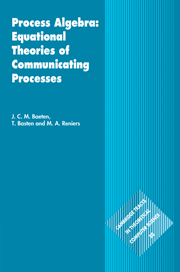Refine search
Actions for selected content:
1983 results in Distributed, Networked and Mobile Computing
13 - Exploiting multiple wireless network interfaces
- from Part III - Advanced energy optimization
-
- Book:
- Smartphone Energy Consumption
- Published online:
- 05 August 2014
- Print publication:
- 07 August 2014, pp 264-280
-
- Chapter
- Export citation
Frontmatter
-
- Book:
- Smartphone Energy Consumption
- Published online:
- 05 August 2014
- Print publication:
- 07 August 2014, pp i-iv
-
- Chapter
- Export citation
3 - Smartphone batteries
- from Part I - Understanding energy consumption
-
- Book:
- Smartphone Energy Consumption
- Published online:
- 05 August 2014
- Print publication:
- 07 August 2014, pp 36-58
-
- Chapter
- Export citation
15 - Example scenarios for energy optimization
- from Part III - Advanced energy optimization
-
- Book:
- Smartphone Energy Consumption
- Published online:
- 05 August 2014
- Print publication:
- 07 August 2014, pp 297-314
-
- Chapter
- Export citation

Smartphone Energy Consumption
- Modeling and Optimization
-
- Published online:
- 05 August 2014
- Print publication:
- 07 August 2014

Process Algebra: Equational Theories of Communicating Processes
-
- Published online:
- 05 July 2014
- Print publication:
- 16 December 2009
10 - Asymptotic analysis of queues
- from II - Performance analysis
-
- Book:
- Communication Networks
- Published online:
- 30 January 2019
- Print publication:
- 14 November 2013, pp 290-322
-
- Chapter
- Export citation
I - Network architecture and algorithms
-
- Book:
- Communication Networks
- Published online:
- 30 January 2019
- Print publication:
- 14 November 2013, pp 5-6
-
- Chapter
- Export citation
4 - Scheduling in packet switches
- from I - Network architecture and algorithms
-
- Book:
- Communication Networks
- Published online:
- 30 January 2019
- Print publication:
- 14 November 2013, pp 86-109
-
- Chapter
- Export citation
Frontmatter
-
- Book:
- Communication Networks
- Published online:
- 30 January 2019
- Print publication:
- 14 November 2013, pp i-vi
-
- Chapter
- Export citation
Contents
-
- Book:
- Communication Networks
- Published online:
- 30 January 2019
- Print publication:
- 14 November 2013, pp vii-x
-
- Chapter
- Export citation
Preface
-
- Book:
- Communication Networks
- Published online:
- 30 January 2019
- Print publication:
- 14 November 2013, pp xi-xii
-
- Chapter
- Export citation
1 - Introduction
-
- Book:
- Communication Networks
- Published online:
- 30 January 2019
- Print publication:
- 14 November 2013, pp 1-4
-
- Chapter
- Export citation
3 - Links: statistical multiplexing and queues
- from I - Network architecture and algorithms
-
- Book:
- Communication Networks
- Published online:
- 30 January 2019
- Print publication:
- 14 November 2013, pp 49-85
-
- Chapter
- Export citation
5 - Scheduling in wireless networks
- from I - Network architecture and algorithms
-
- Book:
- Communication Networks
- Published online:
- 30 January 2019
- Print publication:
- 14 November 2013, pp 110-141
-
- Chapter
- Export citation
9 - Queueing theory in continuous time
- from II - Performance analysis
-
- Book:
- Communication Networks
- Published online:
- 30 January 2019
- Print publication:
- 14 November 2013, pp 229-289
-
- Chapter
- Export citation
Index
-
- Book:
- Communication Networks
- Published online:
- 30 January 2019
- Print publication:
- 14 November 2013, pp 349-352
-
- Chapter
- Export citation
7 - Network protocols
- from I - Network architecture and algorithms
-
- Book:
- Communication Networks
- Published online:
- 30 January 2019
- Print publication:
- 14 November 2013, pp 165-194
-
- Chapter
- Export citation
8 - Peer-to-peer networks
- from I - Network architecture and algorithms
-
- Book:
- Communication Networks
- Published online:
- 30 January 2019
- Print publication:
- 14 November 2013, pp 195-226
-
- Chapter
- Export citation
11 - Geometric random graph models of wireless networks
- from II - Performance analysis
-
- Book:
- Communication Networks
- Published online:
- 30 January 2019
- Print publication:
- 14 November 2013, pp 323-339
-
- Chapter
- Export citation
